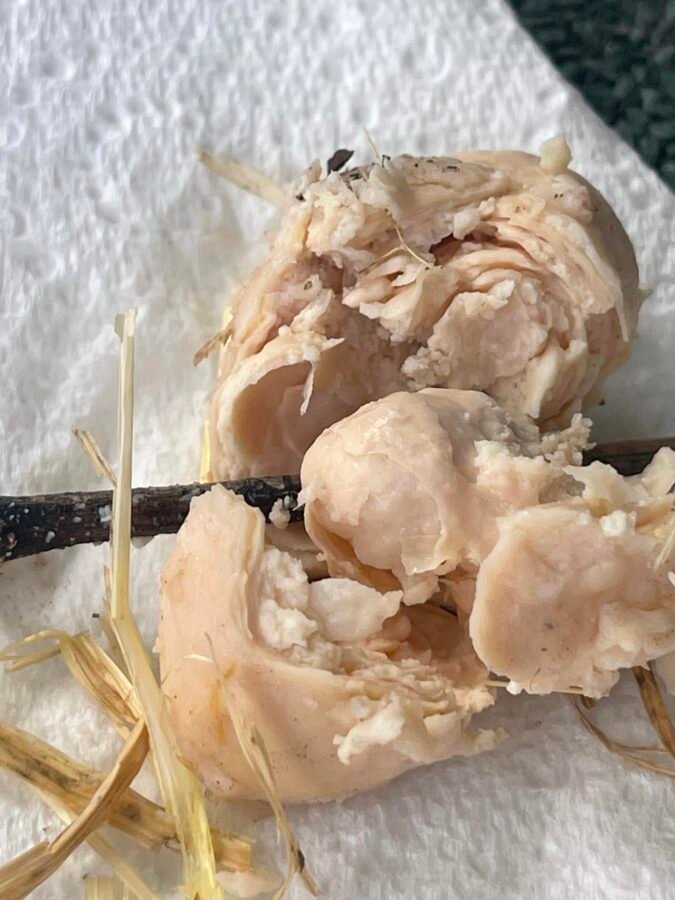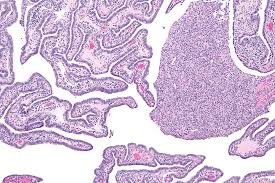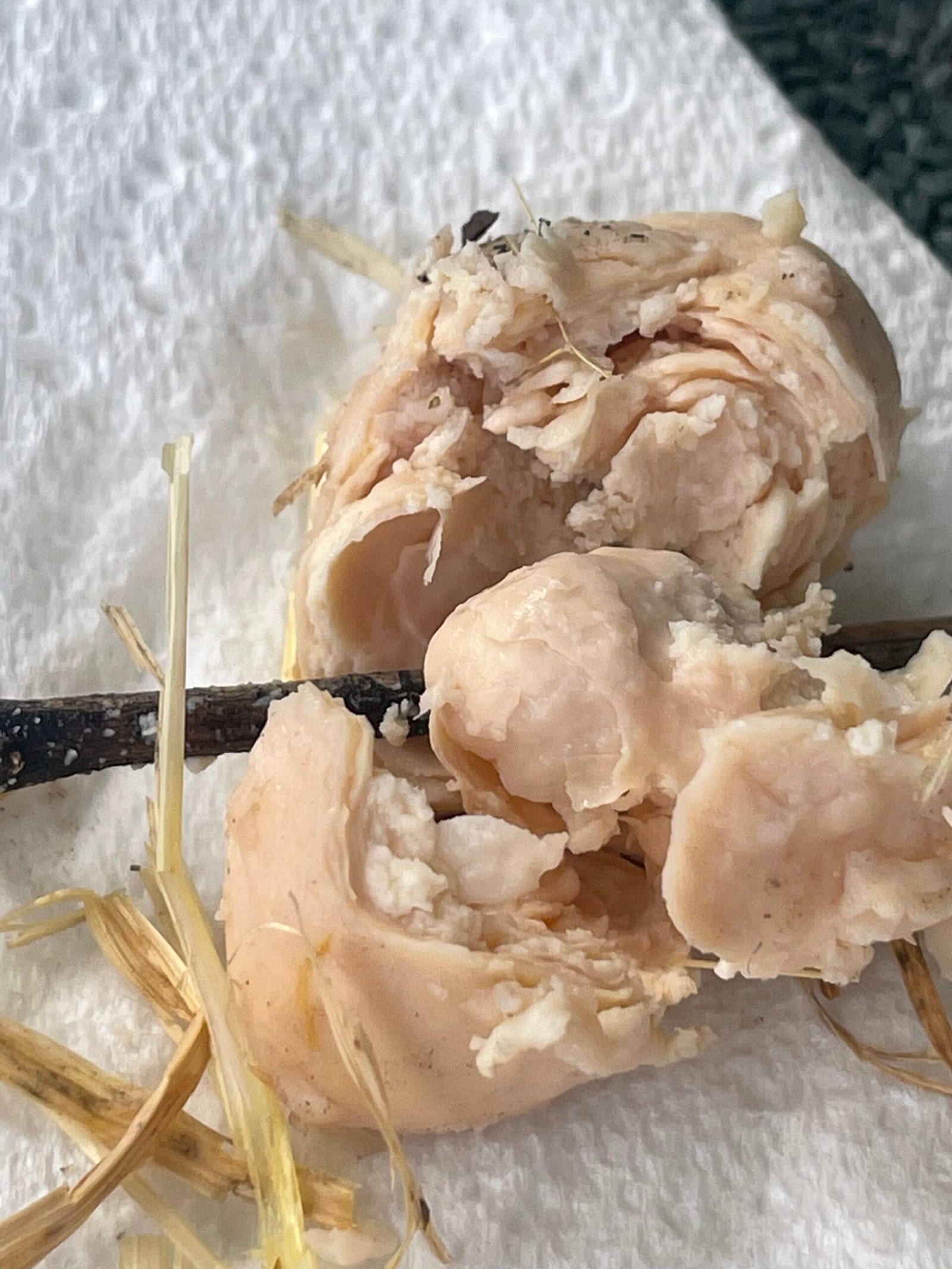Do you suspect your chicken has laid a lash egg? Lash eggs in chickens can be a shock to find in the coop or nesting box. Here we will discuss the causes, treatment and prevention of lash eggs in chickens (also known as ‘salpingitis‘). Read on to find out more.

Finding a lash egg in your chicken coop can be quite a shock at first and is a solid sign that your chicken may be suffering from an infection. In this article we aim to educate the reader about lash eggs, what causes them, the symptoms your hen may be showing and how to treat and prevent lash eggs in chickens.
What this article covers
Below are some quick links. Click any of them to go straight to the section you are interested in – or just carry on reading for the full article!
What are Lash Eggs in Chickens?
Lash eggs, also known as caseous exudate, are not eggs at all. They are abnormal egg-shaped masses produced by hens due to an infection of the oviduct. These masses are composed of tissue, pus, and other materials that are expelled by the hen. They can be quite shocking to find in your nesting box due to their gruesome, squishy, and rubbery appearance.

Causes of Lash Eggs in Chickens
The primary cause of lash eggs is salpingitis, an inflammation and infection of the oviduct. This condition is usually caused by a bacterial or viral infection. The bacteria or viruses gain entry into the birth canal and move up the reproductive tract. Blood can carry infections from the abdominal sac straight to the oviduct, where they can spread from tube to tube.
Various pathogens can cause salpingitis, including bacterial infections such as Escherichia coli, Mycoplasma gallisepticum (causing Chronic Respiratory Disease), Salmonella spp, Streptococcus, and Pasteurella multocida (also known as Fowl Cholera). Other bacteria such as Enterococcus faecalis and Chlamydia psittaci may also be involved. Some viral infections, like Infectious Bronchitis, Newcastle Disease, and Avian Influenza, can cause damage to the reproductive tract of hens, potentially resulting in conditions like salpingitis.
The hen’s immune system reacts by trying to wall off the infection with waxy cheese-like pus. This pus may or may not contain yolk, albumen (egg white), egg shell, egg membrane, blood or pieces of tissue from the ovarian wall.
It usually signals a hormonal change and it is not uncommon to find your hen will go off lay soon after passing a lash egg, and she may or may not come back into lay.

Symptoms of Lash Eggs
Typical symptoms of salpingitis include the production of lash eggs and eggs with stress lines if the hen is still laying. The lash egg appears as an egg, but it is a build up of pus that is gruesome, squishy, rubbery, and covered only by a solid film. It is possible for this egg-shaped monstrosity to contain pus and parts of an egg white, yolk, blood, egg membrane, and oviduct wall tissue.
Other symptoms the hen may be exhibiting include:
- Weight loss.
- Depression.
- Ruffled feathers.
- Enlarged abdomen.
- Soft shell, caseous or inspissated eggs passed.
- Usually none other than finding the object in the nest box.

Treatment for Lash Eggs
If you find a lash egg in your chicken coop, it’s a red flag that your chicken may be suffering from a virus or bacterial infection. It’s important to consult with a vet to identify the exact cause of the lash egg. They may recommend an antibiotic or the inflammation may go away on its own. Antibiotics such as tetracyclines are used to treat lash eggs.
Other treatments may include changes in environment, diet, and hormone levels. Use of anti-inflammatory drugs (NSAIDs like meloxicam) and prostaglandins, like PGE2, can help the chicken’s oviduct squeeze out pus, lash eggs, or fluid that might be stuck in there. Use of lotus leaf extract can also be used to treat salpingitis.
Ensure you remove the infected chicken away from the rest of the flock and thoroughly clean and disinfect the coop with the aim of preventing infection in the rest of the flock. Make sure you practice good personal hygiene and wear gloves while doing this.

Prevention
Prevention is better than cure. It’s important to make sure your chickens develop strong immune systems. Good hygiene is key. Keep the feeders clean, disinfect the water regularly, provide your chickens with a good poultry seed based on their age, and keep their coop clean. Chickens with a history of high egg production that are mainly fed a diet lacking sufficient vitamins and minerals are more susceptible to salpingitis. Also, obese chickens are more likely to develop salpingitis.
In conclusion, while lash eggs can be alarming to find, they are treatable and can be prevented with proper care and management of your flock. Always consult with a vet if you find a lash egg in your coop to ensure the best course of action for your hen’s health.
References
Bumblefoot is another common health condition that chickens can face. Learn how to treat this foot infection at home by reading our guide here.
Chicken Care Shopping List
Are you looking for a shopping list of everything you need when caring for your precious flock? We have put together an easy reference of items for your convenience.


